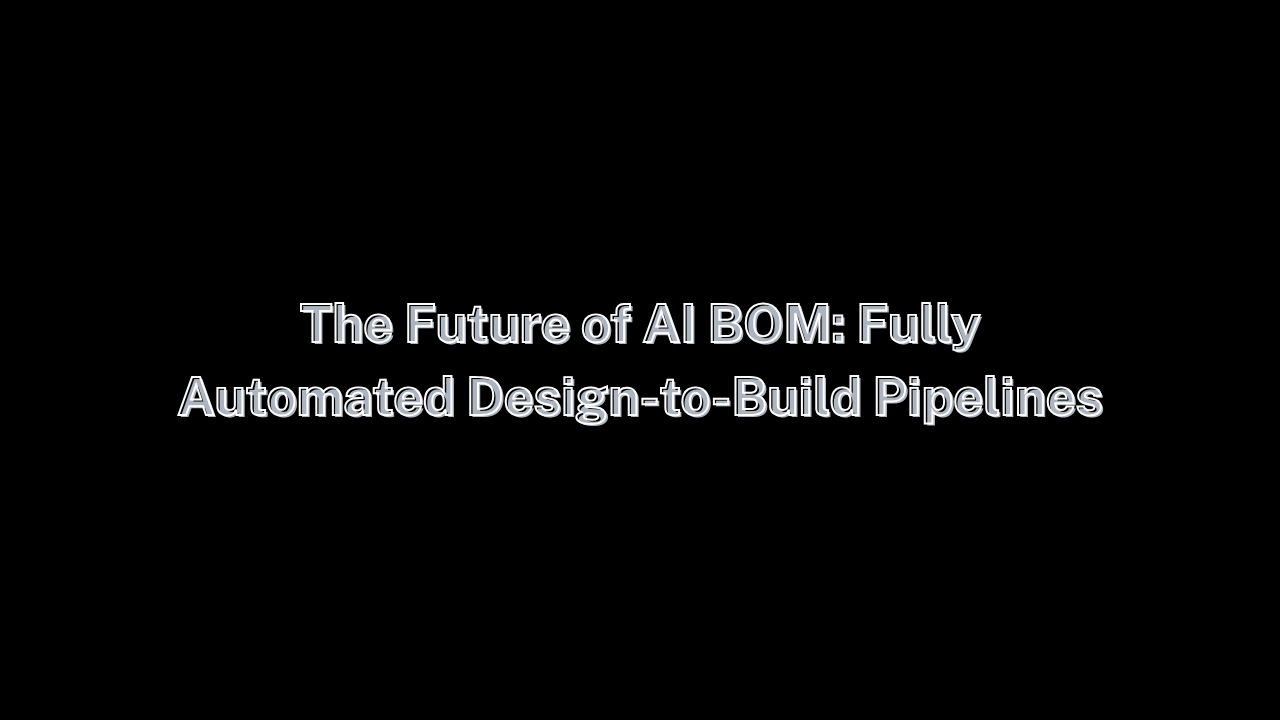As the AV industry embraces digital transformation, the Bill of Materials (BOM) — once a static, spreadsheet-based component list — is undergoing a radical transformation. No longer just a checklist of cables, displays, and processors, the AV BOM is becoming a dynamic, intelligent resource that evolves with every stage of the project lifecycle. And leading this shift is artificial intelligence.
Over the next five years, AI BOM systems will go from assisting designers to becoming central, proactive decision-makers in AV project planning, deployment, and maintenance. In this blog, we’ll explore how AI is already reshaping AV BOM generation, what trends to expect in the near future, and how integrators, consultants, and manufacturers can position themselves to thrive in this new era.
The Traditional AV BOM: Why It Needed to Evolve
Historically, creating an AV BOM was a manual, time-consuming process:
Designers had to sift through product catalogs.
Compatibility and compliance had to be double-checked manually.
Procurement and documentation took hours or days.
Changes in scope often resulted in versioning chaos.
This led to inefficiencies, errors, delays, and bloated costs. As projects became more complex — spanning hybrid workspaces, smart buildings, and multi-vendor integrations — the need for a smarter system became unavoidable.
Where AI BOMs Stand Today
Currently, AI BOM tools offer substantial benefits over traditional methods:
Automated part selection based on design goals.
Real-time compatibility checks between devices.
Dynamic updates when changes are made to room layouts or signal flow.
Vendor integration for pricing, availability, and lifecycle data.
Cloud-based collaboration so teams can co-edit, approve, and deploy AV BOMs.
These are game-changing capabilities, but they’re just the beginning. Over the next five years, expect AI BOM tools to shift from reactive assistants to intelligent, predictive partners in AV system design.
1. AI BOMs Will Learn from Historical Project Data
By 2030, AV design platforms will routinely analyze thousands of past projects to generate recommendations. AI will be trained on:
AV BOMs from similar room types
Project success rates and installation issues
User satisfaction and support tickets
Procurement delays and supply chain risks
With this intelligence, future AI BOM tools will automatically suggest the most effective components, cable lengths, DSP settings, and even labor allocations.
Imagine designing a lecture hall in Boston and your AI suggests AV BOM items based on 100 similar university installs across North America, filtered by acoustic profile, budget, and vendor reliability.
This predictive learning model will reduce design time by over 70% while improving long-term system performance.
2. Natural Language BOM Generation Will Become Standard
In the next few years, AI will be able to generate a complete AV BOM based on simple prompts like:
“Create an AV BOM for a hybrid 10-person conference room with Teams integration, dual displays, ceiling mics, and AV-over-IP distribution.”
Using natural language processing (NLP), the AI will:
Parse the request
Match against known room templates
Select compatible, available devices
Configure signal flow
Generate drawings, pricing, and documentation
This shift will democratize AV design, allowing even non-technical stakeholders — such as architects, facility managers, and end clients — to participate in BOM creation using intuitive interfaces.
3. AI BOMs Will Offer Real-Time Sustainability Scoring
As sustainability becomes a core business requirement, expect AI BOM platforms to include carbon impact analysis, power consumption metrics, and EPEAT/ENERGY STAR certification scoring per part.
When choosing between two display models, AI won’t just compare resolution or price — it will show you:
Total lifetime energy consumption
Recyclability scores
Environmental compliance in different regions
Cost vs sustainability trade-offs
Over time, this will help organizations not only meet green building standards but also adopt procurement practices that align with ESG goals.
4. AI BOMs Will Dynamically Update with Supply Chain Intelligence
Supply chain disruptions are no longer rare — they’re the new norm. Future AV BOM platforms will continuously ingest real-time supply chain data, flagging:
Delays from specific vendors
EOL (end-of-life) announcements
Region-specific shortages
Alternative parts with similar specs
For example, if a specific PTZ camera model faces a 6-week backorder, your AI BOM will instantly suggest a compatible substitute — complete with power, control, and mounting equivalency.
This agility will help integrators meet timelines, avoid rework, and deliver smoother client experiences.
5. AI BOMs Will Integrate Seamlessly with BIM and CAD Platforms
Building Information Modeling (BIM) is standard in architecture, and AV is finally catching up. Within five years, AI BOM tools will directly integrate with BIM, CAD, and 3D modeling software.
This means:
BOMs generated visually from 3D room models
Real-time AV placement simulation (e.g., mic pickup, speaker coverage)
Space and infrastructure checks (e.g., rack space, ventilation)
Costing updates as you move devices within a digital twin
This will reduce errors and mismatches between design and installation, leading to faster approvals and fewer on-site surprises.
6. AI BOMs Will Offer Predictive Maintenance Planning
Future AV BOMs will include a predictive lifecycle timeline. AI will analyze:
MTBF (mean time between failures) data
Historical ticket logs from similar installs
Firmware update frequency
Warranty expiration
With this, the AV BOM becomes a living maintenance roadmap. AI will notify when:
A projector lamp is likely to fail
A switch needs firmware updates
A codec is due for replacement
A cable has exceeded its bending stress tolerance
Facilities teams can act proactively, reducing downtime and extending equipment life — all driven from the initial AV BOM data.
7. AI BOMs Will Include Labor and Installation Time Estimates
Time is money, especially in AV. Over the next five years, AI will calculate labor hours based on:
Room complexity
Rack density
Programming and commissioning workload
Mounting difficulty and cable length
These estimates will feed into:
Bid proposals
Resource scheduling
Risk analysis
Combined with supplier timelines, this will give clients a real-world delivery forecast — not just a parts list. The AV BOM becomes a true project management asset.
8. AI BOMs Will Learn Your Preferences and Style
Personalization will be a huge differentiator. Over time, AI BOM platforms will:
Learn your preferred vendors and models
Prioritize certain features (e.g., PoE, Dante, BYOD support)
Maintain visual and acoustic brand consistency
Respect budget caps and margin targets
Think of it as a “design fingerprint.” Your AI BOM assistant will begin to suggest options that align with your philosophy, speeding up decision-making and reinforcing your design language across projects.
9. AI BOMs Will Be Auditable and Standards-Compliant
Compliance is becoming non-negotiable, especially in government, healthcare, and education. Future AI BOM platforms will embed:
NEC and AVIXA standards validation
ADA (Americans with Disabilities Act) compliance flags
Documentation for commissioning and code inspection
Encryption and network isolation checklists
Before you submit a design, AI will pre-check it against required regulations and flag issues — saving you time, reputation, and legal exposure.
10. AI BOMs Will Be Multilingual and Multicultural
Global AV firms increasingly serve clients across borders. Future platforms will offer:
Multilingual BOM generation
Metric/imperial toggles
Regional compliance rules
Translated documentation sets
So whether you’re deploying in India, Germany, or Brazil, your AV BOM can adapt to cultural, legal, and logistical expectations — automatically.
Summary Table: How AI BOM Capabilities Will Evolve
AI BOM Capability Current (2025) Future (2026–2030)
BOM Generation Speed Minutes Seconds via natural language input
Component Selection Intelligence Based on templates Based on historical project success & usage data
Compatibility Checking Basic matching Real-time simulation + protocol compliance
Sustainability Scoring Manual Automated with real-time impact metrics
Supply Chain Awareness Static Dynamic, real-time vendor & logistics insight
BIM/CAD Integration Minimal Deep integration for spatial-aware AV BOMs
Maintenance Planning Post-installation Included in AV BOM as predictive recommendations
Labor/Time Estimation Manual input AI-generated from room design and part complexity
Personalization Template-based AI-learned preferences across projects
Compliance Checking After design Proactive, automated validation during design
What This Means for AV Professionals
For integrators, consultants, and designers, the transformation of AV BOM generation via AI presents both opportunity and challenge.
Opportunities:
Shorter design cycles
More accurate proposals
Smarter procurement
Better documentation
Predictable performance
Competitive edge
Challenges:
Need to learn and trust new tools
Integration with legacy workflows
Managing rapid AI updates
Redefining the role of the AV designer
To stay ahead, professionals should invest time in AI training, choose platforms that support open standards, and focus on value-added activities that AI can’t replicate — like human-centric UX, creative problem-solving, and client relationships.
Conclusion
In the next five years, AI BOM tools will become central to every stage of AV design and delivery. What started as an automation tool for part selection is evolving into a powerful design intelligence engine — one that learns, predicts, adapts, and collaborates with human designers.
AV professionals who embrace this transformation won’t just build systems faster. They’ll build smarter, greener, more scalable systems with fewer errors and more satisfied clients.
Read more: https://www.ganjingworld.com/news/1hndtqbphrbh6fO7LuXEUrfLp1t41c


